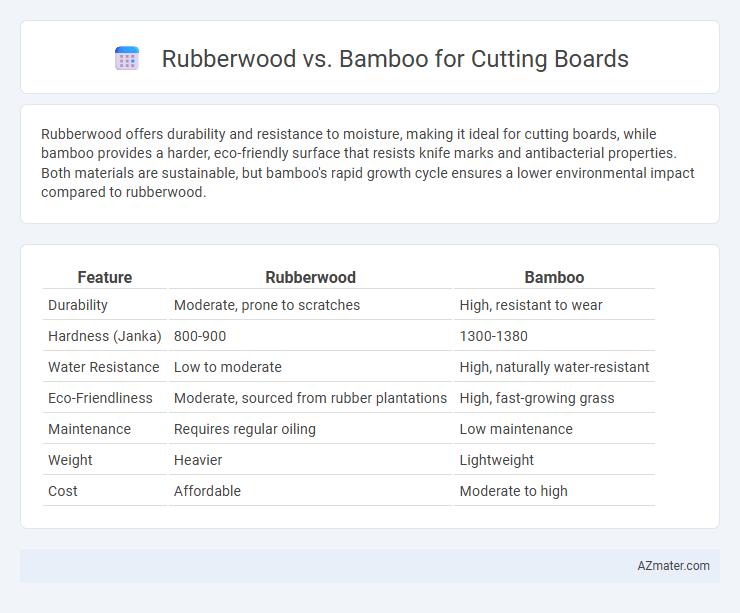Rubberwood offers durability and resistance to moisture, making it ideal for cutting boards, while bamboo provides a harder, eco-friendly surface that resists knife marks and antibacterial properties. Both materials are sustainable, but bamboo's rapid growth cycle ensures a lower environmental impact compared to rubberwood.
Table of Comparison
| Feature | Rubberwood | Bamboo |
|---|---|---|
| Durability | Moderate, prone to scratches | High, resistant to wear |
| Hardness (Janka) | 800-900 | 1300-1380 |
| Water Resistance | Low to moderate | High, naturally water-resistant |
| Eco-Friendliness | Moderate, sourced from rubber plantations | High, fast-growing grass |
| Maintenance | Requires regular oiling | Low maintenance |
| Weight | Heavier | Lightweight |
| Cost | Affordable | Moderate to high |
Introduction to Rubberwood and Bamboo Cutting Boards
Rubberwood cutting boards are crafted from the hardwood of the rubber tree, known for its durability and resistance to knife marks, making them ideal for everyday kitchen use. Bamboo cutting boards, made from fast-growing grass, offer a sustainable and eco-friendly option with natural antimicrobial properties and a lightweight feel. Both materials provide sturdy surfaces, but bamboo is often favored for its rapid renewability, while rubberwood is prized for its dense, close grain structure that reduces bacterial absorption.
Material Overview: Rubberwood vs Bamboo
Rubberwood is a hardwood derived from the Para rubber tree, known for its moderately dense structure and moisture resistance, making it a popular choice for durable cutting boards. Bamboo, a fast-growing grass with a dense and fibrous composition, offers remarkable hardness and natural antimicrobial properties, enhancing cutting board hygiene. Both materials provide sustainable options; rubberwood is typically sourced from plantation trees after latex harvesting, while bamboo regenerates quickly without replanting, influencing their environmental impact and durability in kitchen use.
Sustainability and Environmental Impact
Rubberwood is a byproduct of the latex industry, harvested from mature rubber trees after their latex production declines, making it a sustainable choice that utilizes existing resources without additional deforestation. Bamboo grows rapidly and regenerates quickly without the need for replanting, contributing to lower environmental impact through efficient land use and carbon sequestration. Both materials offer eco-friendly options, but bamboo's fast growth and rubberwood's resource efficiency make them preferred for sustainable cutting boards.
Durability and Longevity Comparison
Rubberwood cutting boards offer high durability due to their dense grain structure, resisting knife marks and warping over time. Bamboo cutting boards are harder and more resistant to scratches and moisture, which contributes to their long lifespan and reduced bacterial growth. Both materials provide excellent longevity, but bamboo generally requires less maintenance to maintain its durability in a kitchen environment.
Knife Friendliness: Which is Gentler on Blades?
Rubberwood cutting boards are known for their relative softness, providing a surface that is gentle on knife blades and helps maintain sharpness over time. Bamboo, while harder and more durable, tends to be more abrasive, which can dull knives more quickly compared to rubberwood. Choosing rubberwood for cutting boards offers a balance of durability and knife friendliness, making it an excellent option for preserving blade edges.
Maintenance and Cleaning Requirements
Rubberwood cutting boards require regular oiling with mineral oil to prevent drying and cracking, and they should be cleaned with mild soap and warm water, avoiding soaking to maintain durability. Bamboo cutting boards are naturally resistant to moisture and bacteria, demanding less frequent oiling, but still benefit from hand washing and prompt drying to prevent warping and mold growth. Both materials should never be placed in the dishwasher, as high heat and prolonged water exposure can cause damage.
Aesthetic Differences: Appearance and Style
Rubberwood cutting boards feature a consistent light brown tone with subtle grain patterns that offer a warm, traditional look, enhancing classic kitchen styles. Bamboo cutting boards showcase a distinct linear grain with a golden-yellow hue that darkens over time, providing a modern, eco-friendly aesthetic. The contrasting textures and colors between rubberwood's smooth surface and bamboo's striped appearance make each material unique for various design preferences.
Cost Comparison: Rubberwood vs Bamboo
Rubberwood cutting boards generally offer a more budget-friendly option compared to bamboo, with prices often 20-30% lower for similar sizes and thicknesses. Bamboo cutting boards can be pricier due to their sustainability appeal and dense grain structure, which enhances durability and resistance to knife marks. For cost-conscious buyers, rubberwood provides excellent value without significantly compromising on quality or longevity.
Pros and Cons of Rubberwood Cutting Boards
Rubberwood cutting boards offer durability and resistance to cracking due to their dense grain, making them ideal for regular kitchen use. They are eco-friendly as they utilize reclaimed hardwood from rubber trees at the end of their latex-producing cycle but can be prone to absorbing moisture if not properly sealed, potentially leading to bacterial growth. Compared to bamboo, rubberwood boards tend to be heavier and may require more maintenance to prevent warping and prolong lifespan.
Pros and Cons of Bamboo Cutting Boards
Bamboo cutting boards are highly durable, resistant to knife scarring, and naturally antibacterial, making them a hygienic choice for kitchen use. They are lightweight, eco-friendly due to rapid bamboo growth, and less prone to warping compared to hardwood boards. However, bamboo can be harder on knife edges and requires regular oiling to prevent cracking and maintain longevity.

Infographic: Rubberwood vs Bamboo for Cutting Board
 azmater.com
azmater.com